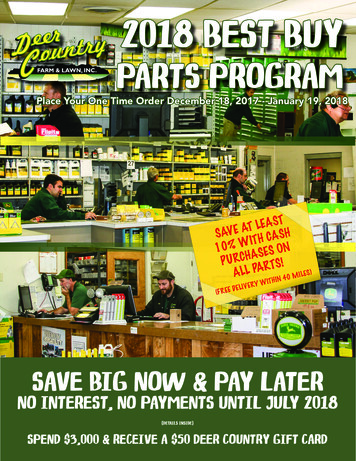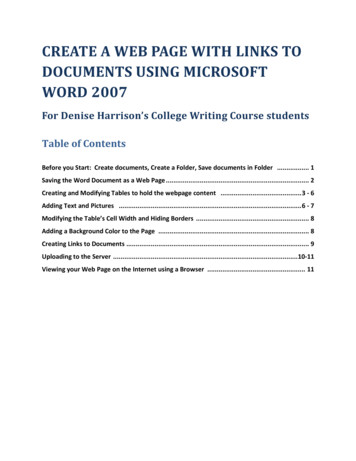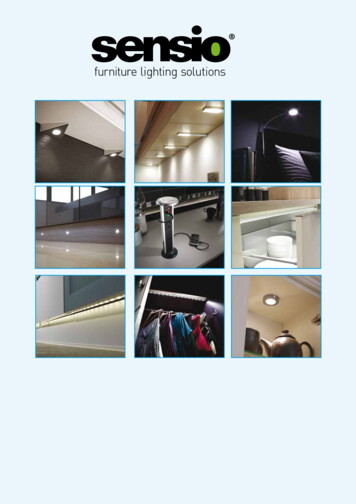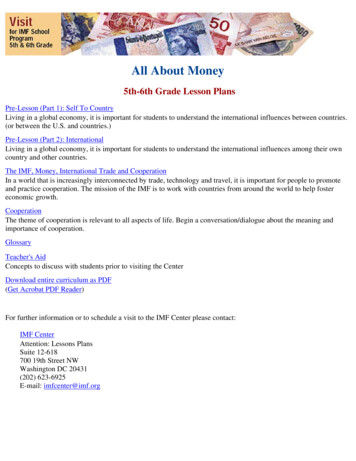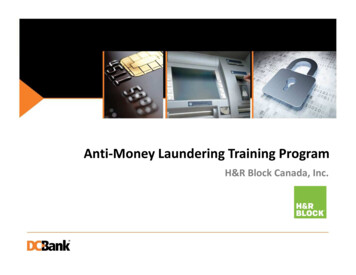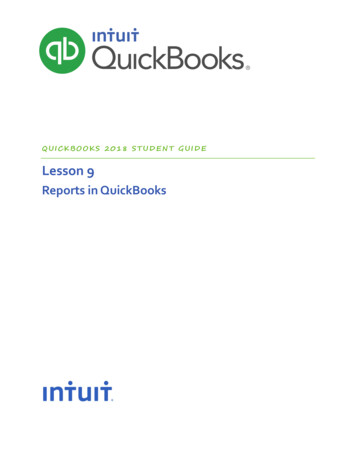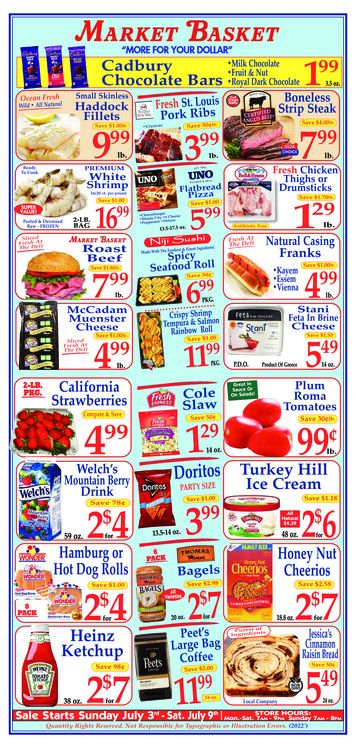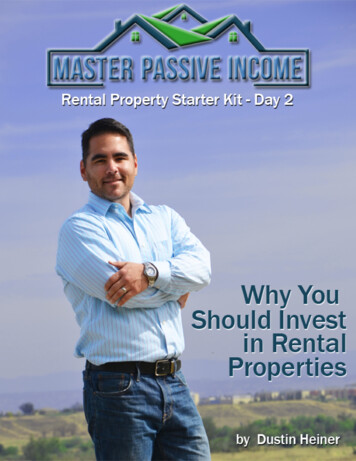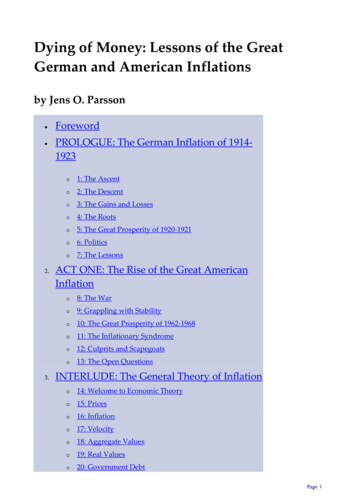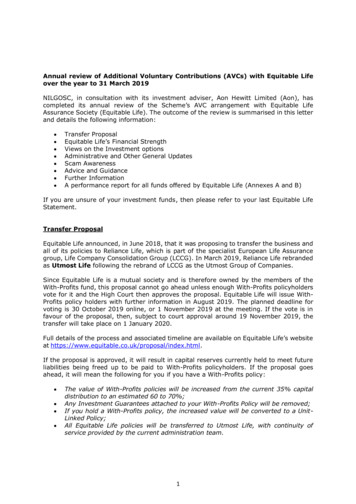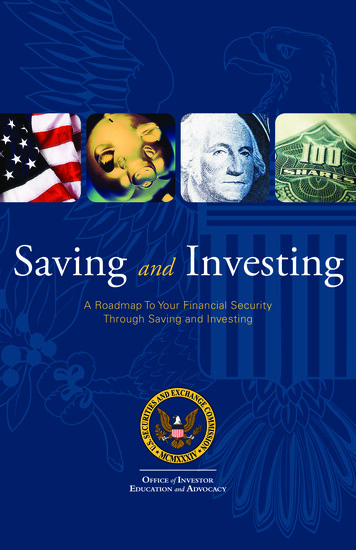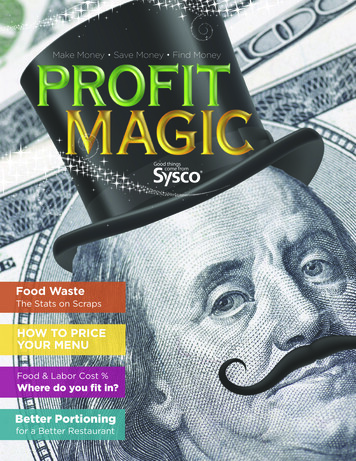
Transcription
Make Money Save Money Find MoneyFood WasteThe Stats on ScrapsHOW TO PRICEYOUR MENUFood & Labor Cost %Where do you fit in?Better Portioningfor a Better Restaurant
The Profit Equation 3Food & Labor Cost Percentages 4The Magic Nickel 5Balancing The Profit Equation 6Portion Control Profit Triangle 8Profit Margin 10Portioning 14Buy Smarter, Serve Less, Make More 15Restaurant Portion Control 16Better Portioning, Better Restaurant 17Food Waste 18Food Waste by the Numbers 19Conserve & Control 21The Cost of Not Portioning 23Portion Audit Form 23Pricing Your Menu 25How to Price Your Menu 26Boosting Profitable Items 28Food Cost 29Tips & Tools for Controlling Costs 30Cut Your Food Cost by 10% 33
THEEquation3
Common Foodand LaborCost PercentagesArticle by Steven Buckley, Demand MediaIf you are running a restaurant or food service business, you understandthat the most important costs under your control are food (includingbeverages) and labor costs -- together, known in the industry as primecosts. Being able to compare these costs -- in a percentage format -against typical scenarios of other restaurant businesses is helpful in themanagement of your business.Costs Vary Widely by Type of RestaurantBoth food and labor costs vary with the type of food service operation.As a rule, luxury restaurants will have higher food and labor cost percentages than casual dining or fast-food restaurants. The product sales mix,quality of food and service, pricing and hours of operation will impactyour food and labor cost percentages. Furthermore, state minimumwage differentials and differences in tip credit allowances (towardminimum wage) affect the labor cost percentage. The extent of beveragessales -- as part of the food mix -- has a considerable impact on total foodcost percentages.How Food and Labor Costs are CalculatedFood and labor costs are calculated as a percentage of the total volumeof sales. If a restaurant does 20,000 per week and the total cost of foodand beverages is 7,000 for that week, then the food cost is considered35%. If, at the same restaurant, labor (including payroll taxes andbenefits) equal 5,000 for the week, then the labor cost is 25%.Total prime costs are 60% in this example.What are the Ranges?Certain fast food restaurants can achieve labor cost as low as 25%, whiletable service restaurants are more likely to see labor in the 30% to 35%range. Food costs (including beverages) for the restaurant industry runtypically from the 25% to 38% range, depending upon the style ofrestaurant and the mix of sales.Look at Prime Costs to Determine SuccessIn order to make money in the restaurant business, prime costs shouldgenerally be in the 60% to 65% range. How that breaks down betweenfood and labor is less important than achieving a prime cost maximumthat produces a satisfactory profit. So if one of the prime costs is in thehigher range, the other prime cost must be in the lower range to achieveprofitability. Remember it is the combination of food and labor thatcreates the bottom line.43CalculatingPrime CostThough percentages of food and labor vary, it isthe combination of the two that determinesyour success or failure.PRIME COST the grand total of your total costof goods sold, which includes both food cost,beverage cost and liquor (also known as pourcost), and total labor cost.EXAMPLE OF CALCULATING PRIME COSTSales 20,000100%F&B COGS 7,00035%Total Labor Cost: 5,00025%incl. payroll for salaried & hourly staff,payroll taxes and benefitsPRIME COST: 12,00060%
THEMAGIC NICKELThe Income StatementIf there's only a nickel in profit for every dollar in revenue, where does the other 95 go?Let's follow the average dollar in revenue as it gets eaten up.RevenueThis is mostly food and beverage sales (not includingsales tax).Income StatementRevenuePrime CostsPrime Costs take a huge bite -- nearly 65 -- out of everydollar earned. Prime Costs are total of Food, Beverageand Direct Labor Costs. Food and beverage costs typicallyaccount for about 33 out of every dollar, and direct laborfor approximately 30 . It's no wonder that your abilityto control costs and produce profit is integrally tied toPrime Cost control.Other Controllable ExpensesThis expense category includes employee benefits, music& entertainment, marketing, energy, administrative andgeneral, repairs and maintenance and direct operatingexpenses. It usually takes 23 of each 1 to pay"Other Controllable Expenses."Operating IncomeThis is also known as "Income before Occupation Cost."This is what's left after Prime Costs and ControllableExpenses are paid. Operating Income is a reflection of theoverall health of the restaurant. It's like a report card forunit management and it's usually stated in a percentage.In our example we have 14 left.That's a 14% Operating Income.But remember.We haven't paid the rent yet!Occupancy CostsOccupancy Costs include the typical line item expensesassociated with the "Brick and Mortar" of a restaurant'sphysical plant: rent, mortgage payments, real estate taxes,fire and casualty insurance, personal property taxes, etc.Rent and lease expenses run around 7 on average andthe rest adds up to 2 . Whew! We just made it.What's Left?A Nickel. Just 5 in profit on a dollar in sales-and we haven't even paid interest on any debtor figured in depreciation!Food & Beverage Sales 1.00Prime CostsFood & Beverage CostsDirect Labor Cost 0.33 0.30Total Prime Costs 0.63Other Controllable ExpensesEmployee BenefitsDirect Operating ExpensesMusic & EntertainmentMarketingEnergy & Utility ServicesAdministrative & GeneralRepairs & Maintenance 0.06 0.05 0.01 0.02 0.03 0.04 0.02Total Other Controllables 0.23Operating IncomeIncome Before Occupancy Costs 0.14Occupancy CostsRent / Lease ExpenseProperty Taxes & Insurance 0.07 0.02Total Occupancy Costs 0.09The Magic Nickel 0.055
How to Balancethe Profit Equationwww.therestaurantblogger.comToo many restaurants focus solely on the bottom line – profits. We lose sight of everything else that is important and how wegot there. Owners are so focused on profit that they become entangled in two objectives; increasing revenue and cutting cost.Rule #1: Reduce Labor CostManaging your labor cost is part of effectively scheduling your staff.The other half is controlling total wages. Labor cost usually becomesa problem when a restaurant under or over staffs. The commonbelief is reducing labor cost will save you money.As this may be true, owners/managers tend to forget that understaffing leads to unsatisfactory service which ultimately canaffect a customer’s willingness to return which in affect leadsto lower revenues.The rule of thumb based on a full-service restaurant, labor costshould run 28% to 30% of total sales. These percentages do notinclude employee benefits which normally run 5% to 6% oftotal sales.Solution:- Forecast daily, weekly and monthly sales to schedule staffaccording to expected sales.- Shifts should be staggered to allow sufficient preparation timefor anticipated busy hours.- Be familiar of the minimum and maximum number of staffrequired to operate efficiently on a daily basis.Rule #2: Reduce Food CostControlling a restaurant’s food cost is crucial to the survival ofa restaurant. Understanding the actual costs of each food item canreduce unnecessary wastage and spoilage. Portion control is a majorfactor in controlling the restaurant’s overall food cost.Higher food costs can be due to over portioning, ineffectivepricing, poor inventory control and food purchasing andreceiving issues.On the other hand, lower food costs does not necessarily equalto better management. Food cost should remain reasonable andbe / – 1% to 2 % within the industry average. Managers/ownerssometimes make the mistake of reducing the food cost too low andsacrifice the overall quality of food. Under portioning is also a majorfactor in lower food costs but customers will soon perceive thistactic as a decline in value.While food cost generally runs at 28% to 32% of total sales, it ispossible to have food costs as high as 40% or above. Higher foodcosts are often found in upscale fining dining establishments thatfocus on premium and expensive ingredients such as seafoodand steak. On the other hand, food costs can be as low as 20%which can be found in lower cost foods such as pizza or pastathemed restaurants.Solution:- Educate your staff on the affects of food costs to total sales.A large part of effectively controlling your restaurant’s foodcost is training your staff.- Proper inventory control will allow you to stock items accordingto projected sales. More attention should be given towards higherpriced food items on the menu.- Compare menu items and analyze the price versus the cost whilecomparing this to the overall popularity of the menu item.High priced, low sale items should be reconsidered or removed.- Managers/owners should consistently review their current vendoragreements to ensure best prices are being offered.- At the same time, receiving goods that do not meet qualitystandards can significantly affect your food cost due to highwastage. Restaurants should be strict on quality control issuesand immediately inform suppliers and bad shipments.Rule #3: PriceImplementing price changes can be both positive and negative forthe restaurant. If done correctly, the restaurant should see an improvement in sales.Solution:Identify and separate items on the menu based on popularity.The common mistake among restaurants is increasing a popularitem too high too fast. Customers are price conscious and shouldnot be regarded as unintelligent.Price increases should be implemented in small increments overa longer period of time versus short term such as a month.Increasing prices by up to 1 can drive customers away whomay have been your most loyal customers.Involve your staff and don’t be afraid to ask them how muchthey would be willing to pay for a particular menu item. Be surewhatever item you do decide to change that there is still valuecreated through the quality or portion provided in comparisonto the price.Conclusions:A restaurant needs to spend money in order to make money.Cutting costs is only part of the solution to make more money.You need to understand the components of the profit equationand analyze the steps required to get the results you want.Until the proper steps have been determined then the appropriatemethods can be applied. A restaurant’s ability to achieve its profittarget is greater when focus is placed in the right areas.DID YOU KNOW?6The average food cost across the U.S. in 2014: 35.7%
7
The Portion ControlProfit TriangleDo you know how much moneyyou’re tossing around?Article by Dave Ostranderwww.bigdaveostrander.comQuickly, tell me how much it costs to make a 14" cheese, pepperoni,ham and mushroom pizza in your store. I'm not surprised you couldn't blurt out the answer. In these times of unstable cheese pricingand invoice creep, it's easy to neglect one of the most importantbuilding blocks of profitability - food costs. Costing out pizza is notan easy task. It's a lot like making soup. An ounce of this, and ounceof that, a couple ounces of other stuff. It's not uncommon to have adozen components to keep a handle on. Add in the stress of a rushand it's no wonder we scratch our heads when the accountant questions our food cost percentage on the P & L Statement.The reason we fail to hit our ideal food cost is fairly simple to identify,but much harder to fix. Making pizza is no different than any manufacturing process. We buy raw goods, assemble them and sell themfor a profit. Let us look at, and analyze all three parts of this profitequation.Employees aren’t asconsistent as you think.Unless you portion control the assemblyprocess, you will never control food costswith as much pinpoint accuracy as weighingand measuring your product.Part 1: Be a Smart BuyerThe first deals with buying. This is the least important part of theequation. Sure, if your supplier is gouging you on price you will notmaximize profitability. This is less common than you may think. Mostsuppliers are above the board and price their products competitively. If they didn't they wouldn't have any customers for long.An educated buyer will learn how to determine if the pricing is competitive and fair. They will buy cheese on a program that follows theweekly national cheese markets. They will know that tomato saucewill be going up this pack season because there is a 20% shortageon California Growers' yields this year.Insider information is available for the asking from good suppliers.Don't expect the sales-reps to know all of the answers. They have toomany items on their plate to track, but their buyers know. Don't beafraid to ask for their predictions. After all, you're in this together.This is a co-dependant relationship. You win, they win. You lose, theylose. It's that simple. My observations indicate that too many operators exert too much mental energy playing mind games with reps.Get off your power trip and put your expectations in writing, havehigh expectations and go for it. If a portion of that energy was diverted to the following parts of the profitability triangle, profitswould dramatically go up.
Part 2: Assembly - Being Right on the MoneyYou own the assembly portion of the profit triangle totally.All too many operators let their employees free throw toppingon their pies. This is not the way to get rich and famous. Is therea right way? There is no one right way, but anything other thanfree throwing will dramatically improve your bottom line.My personal experiences have resulted in a reduction of cheeseusage by 20% and protein and veggie toppings by 10 to 15%.So, ways to achieve ideal food cost are using: In-Line Digital Scales Spoodles, (flat bottom ladles) Cups with ounce graduations.y inBua rtSmOn paper, I was supposed to be at a certain percentage, but in reality,according to my P & L statements, I was way off. How could this be?The answer was in inconsistent portioning. Some of my cooks had aheavy hand and some light. I needed to provide them the tools theyneeded to do the job right. Then, wouldn't you know it; prices wentup across the board. Instead of re-calculating the entire analysis, Icheated. I simply jacked up the prices by nickels, dimes andquarters until I got back to a profitable food cost.I lost track of doing it the right way because I didn't want to repeatthe whole drill again. Time goes on and, pretty soon I lost control offood cost. Profits suffered and I was forced to do the entire studyagain. All of the previous data was pretty much outdated, so I startedfrom scratch. Then, along comes my first computer. I transferred all ofmy data to a crude spreadsheet program and after a couple ofdays of algebra configuring the spreadsheet, I had done it! Fromthen on, all I had to do was update the new grocery pricesonce a month and every cell changed. It was magic. Now Ihad no excuse not to have an iron grip on food cost.Laziness really is the Mother of Invention. Now, if I didn'thit the number on the end of the month statement,it was for another reason other than food portioningand proper pricing. That was a load off my mind.After the launch of the Windows OS, specificallyPortion ControlExcel, the rough-around-the-edges programI created has been updated to a slick, userPROFITfriendly, powerful tool.TRIANGLEfitrorPfongiciPrThe next system will use spoodles that are sized bythe ounce. These guys are either solid or perforated,depending on the topping and are very handy forveggies. Right along the same thought wouldbe using small plastic soufflé cups. Either oneof these systems will make a difference, butare flawed because of over and under fillingthe cups. If you really want to do it right,invest in a great scale. The payback willbe, depending on volume, almostimmediate.gBy far, the best, most accurate method if making consistent pizzais utilizing one or more built in digital scales. The ones I usedwere recessed right into the pizza make table using stainlesssteel raised rails. The LCD readouts were mounted at eye levelwith the pizza-maker. The zero (tare) switch was a pedal on thefloor. This allowed the person to use both hands and not have toreset the scale back to zero with a greasy finger. The ideal scalehas a large Stainless Steel platform, capacity to at least 10#, easyto read LCD and overbuilt to withstand the punishment ofa pizza operation. My personal favorite costs a little morethan normal, but will keep on ticking when the cheaperones quit. This method is exact, idiot proof and fast.I opted to include the cost of the pizza box into the total rather thanhave it show up somewhere else in my accounting. Since more thanhalf of my sales derived from carryout and delivery, this seemed prudent. I then itemized every pizza and determined how much moneyit cost to build the pie. Then, I multiplied that number times the foodcost percentage I was trying to hit. No one hates number crunchingmore than me. This was eight hours of drudgery. Yet, it had to bedone, it was a management function. The results were frightening.I enlisted the help of a computer guru toset up the macros and install buttons anddrag down menus for speed and ease ofConsistent Assemblyuse. Besides computing food cost, it suggestsPart 3: Pricing for Profitabilitya menu price based on whatever percent youI'm embarrassed to share with you how I priced my first menu.want to hit as well as gross profit (contribution margin). I have alsoTo say I plagiarized others would be pretty accurate. At that time,analyzed my competitor's menus on this program and asked hunI couldn't even define food cost, but back then things weredreds of "what if" questions.different. Mozzarella cheese was 42 cents a pound and a 16"six item pizza sold for 4.00. Times change. So we must also.I remember when I did my first real food cost analysis. It wasn'tTying up the Profit Trianglea pretty picture.The first leg of the triangle is buying the best ingredients at the bestprice. Work with your distributors to get to this goal. The second legI'm convinced that a lot of operators don't do them, or do themis assembly. Create a wall chart that tells the pizza makers how muchinaccurately because of the hassle factor. I gathered a dozen reof every item goes on every pizza. The crew members can't possiblycent invoices, a pad of accountant's columnar work sheet paper,eyeball the ingredients as close as a scale. Buy one. The last and mosta calculator, a scale and a dozen corrugated pizza circles. I thenimportant segment of the triangle is the mathematical part. Createwent through the task of making every pizza I had on the menuyour own computer spreadsheet or contact me for a copy of mine.and weighing out every topping. I recorded that data and conIf you implement all three of Profit Triangle Segments you'll neververted the price per pound/case to cost per ounce, and finallywonder how much does it cost or why didn't I hit the right foodcost.cost per pizza.Be an Educated Buyer!An educated buyer will learn how to determine if the pricing is competitive and fair. Insider informationsuch as commodity pricing and market trends will be available for the asking from good suppliers.9
What is the Net-Profit MarginFrom a Restaurant?By Christine Aldridge, Demand MediaAs an owner or operator of a restaurant, there are several key pieces of financial information that you willneed to understand. Net-profit margin, and what directly affects this financial ratio, is probably most important.The net-profit margin directly correlates to how much money the restaurant receives and makes over thecourse of a period of time.Net-Profit MarginYou calculate net-profit margin by dividing net income by sales. Each of these variables are found on the incomestatement for a restaurant, or chain of restaurants. This financial ratio shows how much sales remain once all expenses of the restaurant are paid. Therefore, if your restaurant operates with a 30 percent net-profit margin, then .70 of each sales dollar goes toward paying expenses and .30 goes toward profits.Food CostsThere are two primary types of expenses that greatly affect the net-profit margin of a restaurant; food costs andlabor expenses. Food costs include the purchase price of all food and beverages. Waste and theft are big concernswithin the restaurant industry. Food-safety measures and spoilage can cause food costs to soar, as can theft of expensive foods or alcohol. The weather and economy also play significant roles in determining what your foods are inyour restaurant. A bad storm, drought or rising gasoline prices can cause food prices to climb, which translate intoincreasing food costs for a restaurant.Labor ExpensesThe second expense that is of great concern to managers and owners of restaurants is labor. Labor costs include thewages and salary of management, chefs, cooks, dishwashers, hostesses, servers, bartenders and any other personthat the restaurant employs. Reducing these expenses by "cutting" people, letting them clean up and go home,after the restaurant's rush can help to increase the net-profit margin of the business.Menu PricesIncreasing menu prices can help to offset rising food or labor costs. It can also aid in increasing the net-profit marginof a restaurant. However, if you increase your prices by too much or do not keep them in line with the quality of thefood, the demand for your restaurant will decline. This will actually cause the net-profit margin to decrease overtime since many of your overhead costs will not go down despite less food being sold. This is important to keep inmind when considering ways in which to increase the overall profits of the business.10
Formula for a Net Profit MarginBy Ronald Kimmons, Demand MediaThe net profit of a business is the difference between its gross, or total, profit and its total expenses, including overhead,interest payments and taxes. The net profit margin is the amount of profit a business receives for each unitof sales. After collecting all of the necessary information, businesses can calculate this number with a simple formula.Total RevenueIn calculating net profit margin, a business first must know its total revenue. Total revenue is all money received for saleof products or services on the market. Using a spreadsheet or some other finance or budgeting tool, a business cancalculate total revenue by multiplying the price of a product by total units sold and adding together the total revenuesof all products.Gross ProfitGross profit, according to QFinance, is "difference between an organization's sales revenue and the cost of goods sold."For instance, if a store buys 100 units of a particular ballpoint pen for 2 each and sells them for 3.50 each, the store'sgross profit is 100 ( 3.50 minus 100 times 2, or 150.Net ProfitNet profit is the actual amount of profit that a business generates after all expenses. Businesses figure net profit by takinggross profit and subtracting all expenses, such as overhead, interest payments and taxes. For instance, if a store has 50,000in gross profits, but has to pay 5,000 for rent and utilities, 15,000 for labor, 2,000 in interest payments and 1,000 in taxes,its net profit is 50,000 minus 5,000 plus 15,000 plus 2,000 plus 1,000, or 27,000Net Profit MarginTo calculate net profit margin, a business needs two figures: net profit and total revenue. The business must then dividenet profit by total revenue and multiply this number by 100. The result is a percent. For instance, if a business has 150,000of net profit and 350,000 of total revenue, the net profit margin would be 150,000 divided by 350,000 multiplied by 100,11or 42.857 percent.
What is an “Average Profit Margin Percentage”?By David Sarokin, Demand MediaBusiness owners cannot avoid themathematics of tracking their financesand operations. You cannot determineif your business is successful unless youare fully aware of costs and revenuesand the relation between the two.You can figure your profit margin andyour average profit margin percentagewith some straightforward arithmetic.CostsThe things your business spends moneyon are your costs. These include itemslike materials, salaries, services, postage,rent, taxes and all the other costsneeded to make the business run.RevenueThe other side of your business' financesis revenue -- the amount of money yourbusiness takes in from sales of yourproducts or services.12ProfitAverage Profit MarginProfit is the amount that yourbusiness revenue exceeds yourcosts and is usually figured fora standard time period such asa year or quarter. For example,if your business spends 10,000in a year and has sales of 15,000in the same period, your profit is 15,000 minus 10,000, or 5,000for the year.Your average profit margin,expressed as a percentage, is yourbusiness's profit margin over the longterm, usually an average of severalyears of business activity. It iscalculated by totalling all costs andall profits and finding the overallprofit margin.Profit MarginYour profit margin is your profitexpressed as a percent of costs.A business with profits of 5,000and costs of 10,000 has an annualprofit margin of 5,000 dividedby 10,000, or 50 percent.ExampleA business with costs over a threeyear period of 10,000 in first year, 5,000 in the second year and 20,000 in the third, has total threeyear costs of 35,000. If profits are 5,000 in the first year, 2,000 in thesecond year and 4,000 in the thirdyear, then total three-year profits are 11,000. The average profit marginfor the three years is 11,000 dividedby 35,000, or 31 percent.
The AverageProfit Marginfor a RestaurantBy Aurelio Locsin, Demand MediaPeople often open a restaurant thinking that all it takes for successis excellent cooking. They may ignore basic business principles tobecome part of the 60 percent who fail within three years or less.These principles include securing a good location at reasonablerates; hiring, training and motivating staff; and effective marketing.Ultimately, the key factor in success is maintaining an average-orbetter profit margin year after year.DefinitionsAccording to the "2010 Operations Report" by the NationalRestaurant Association and Deloitte & Touche LLP, restaurant netprofit margins before taxes varied according to restaurant type,as well as by the cost of the average diner check. The report dividedthe costs of each restaurant dollar into three main areas: First werefood and beverages, which covered the cost of preparing meals,as well as coffee, tea, milk, fruit juices and alcoholic drinks. Secondwere salaries and wages, which included regular pay, overtime,vacation, commissions and bonuses. Third were restaurantoccupancy costs, which encompassed rent, taxes and insurance.Full-Service RestaurantsFull-service restaurants at all levels spent about 32 percent of eachdollar on the cost of food and beverages, 33 percent on salaries andwages, and from 5 percent to 6 percent on restaurant occupancycosts. Profit margins, however, varied according to the cost of theaverage check per person. Those with checks under 15 showed aprofit of 3 percent. Those with checks from 15 to 24.99 boastedthe highest profit margin at 3.5 percent. Finally, those with checksof 25 and over had the lowest profits, at 1.8 percent.Limited-Service RestaurantsLimited-service restaurants devoted 32 percent of every dollar tothe cost of food and beverages, which was nearly identical to thecosts for full-service establishments. However, only 29 percentwent to salaries and wages, which was lower than that of full-servicerestaurants. About 8 percent was devoted to restaurant occupancycosts, which was the highest of any type of establishment.Profit before taxes was also the highest for any type of restaurant,at 6 percent.OutlookThese profit margins come from three years of negative salesgrowth, according to the National Restaurant Association. However,as the economy continues to improve for 2011, the associationforecasts a 3.6 percent increase in sales over 2010, which equalsa real 1.1 percent increase when adjusted from inflation.The strongest sales growth --- over 5 percent --- and profits willbe with social caterers, hotel restaurants and nursing homes.The South Atlantic part of the country will post the strongest salesgrowth, with North Carolina, Idaho and Virginia leading the pack.Establishments who take advantage of social media, mobile phoneapplications and online review sites can increase their profitability.This is because more consumers are relying on this technologyto determine where to eat.13
14
Buy Better. Serve Less. Make More.Extra Long Fry - 7 oz. PortionLine Flow Fry - 8 oz. Portion30 lb. Case costs 36.19480 oz. per case 0.075 per oz.30 lb. Case costs 21.29480 oz. per case 0.044 per oz.7 oz. Portions 68.57 servings per case8 oz. Portions 60 servings per caseSuggested serving sell price 2.99Suggested serving sell price 2.99Revenue per case 205.02Minus case cost - 36.19 168.83Revenue per case 179.40Minus case cost - 21.29 158.11Makes 10.72 Extra Per CaseIf you sell 500 cases per year, you make 5,360 MORE than selling the “cheaper” FryBetter quality productSmaller servingMore profit .Magic!15
RESTAURANTPORTIONCONTROLHow to Reduce Portion Sizesand Still Keep Customers HappyArticle by Lorri Mealy for www.restaurants.about.comOne of the reasons that franchise chainrestaurants are so successful is because theyhave menu portions under control. Whetheryou go into an Applebee’s in New York or inMontana, you’ll be served the same food inthe same portion sizes. Customers like thatpredictability. And by streamlining theirportion sizes, chain restaurants ensurehealthy profit margins. Even if you owna small, independent restaurant, portioncontrol is still an important factor in keepingyour business profitable.What is Restaurant Portion Control?Just as individuals need to watch the portionsizes of foods they eat,
The Profit Equation 3 Food & Labor Cost Percentages 4 The Magic Nickel 5 Balancing The Profit Equation 6 Portion Control Profit Triangle 8 Profit Margin 10 . Food and labor costs are calculated as a percentage of the total volume of sales. If a restaurant d oes 20,000 per week and the total cost of food and beverages is 7,000 f or that week .
